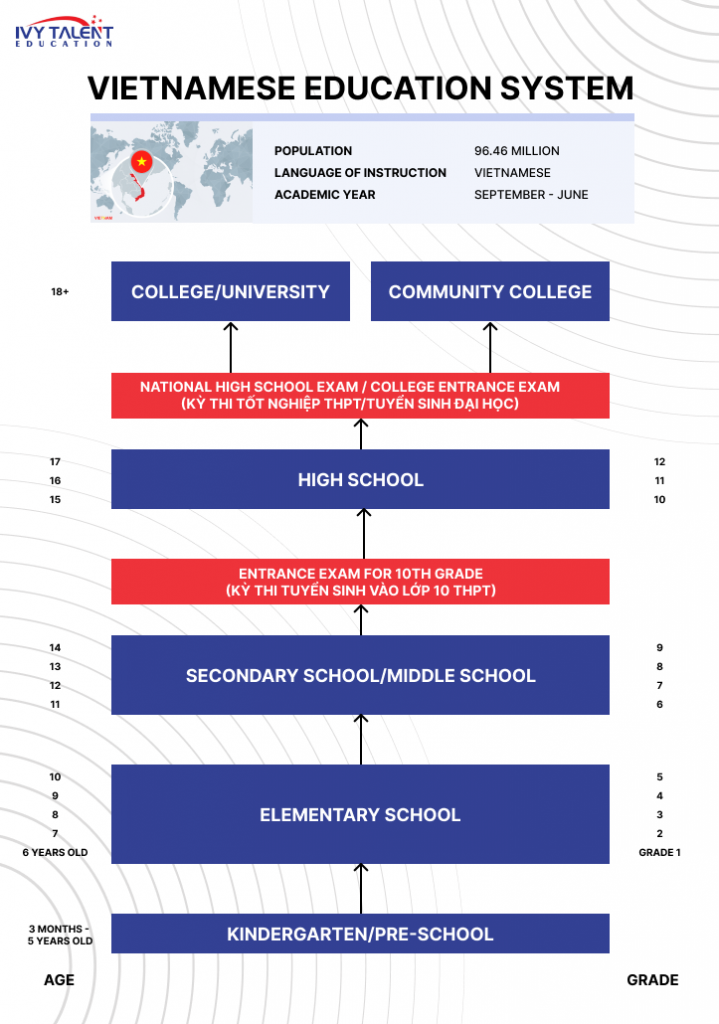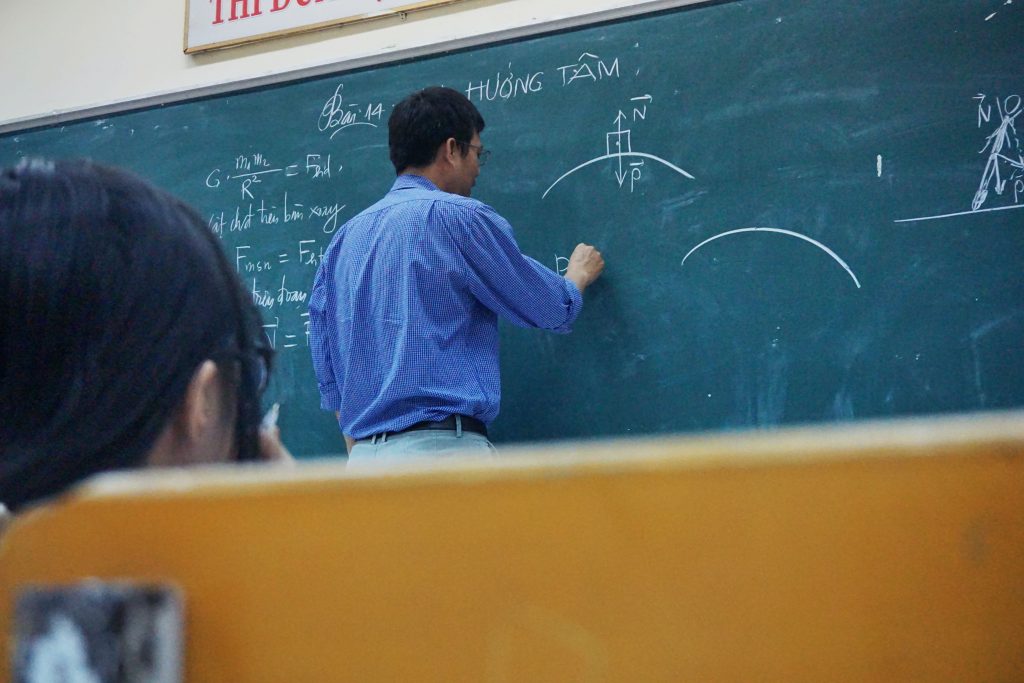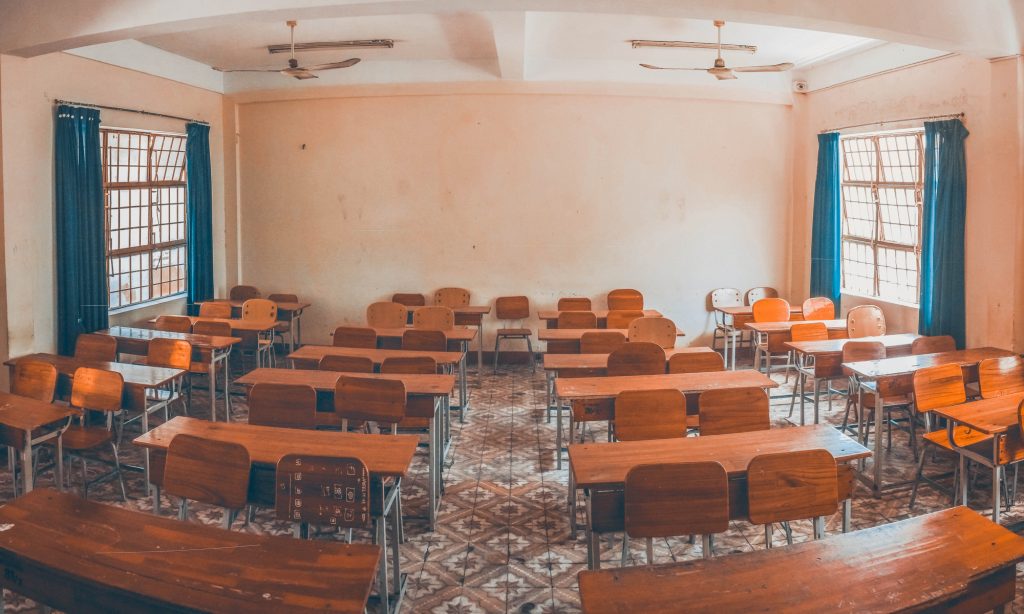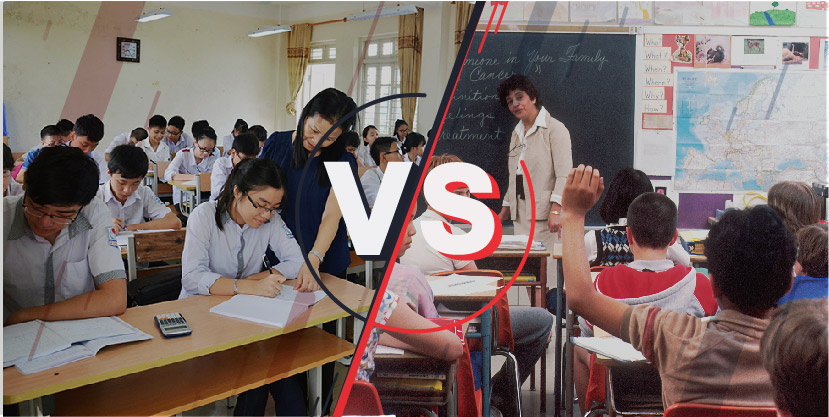At the time of writing, students from Vietnam are the sixth largest group of students studying abroad in America, as more students attend American universities and high schools. The increase in Vietnamese students studying abroad indicates a strong interest in the American educational system. This is rooted in the significant differences between American and Vietnamese education systems. Ivy Talent will further discuss and analyze the differences and explain the reason why families are more likely to send their children to the United States to study abroad.
For this article, we discuss Vietnamese public and private schools following the Vietnamese curriculum rather than international schools. International schools in Vietnam have adopted the Western education system for most of their courses and teaching methods. Therefore, the instruction at international schools in Vietnam is closer to American education than a regular Vietnamese school.
Vietnamese Educational System Overview
In Vietnam, the general education system is:
Kindergarten (3 years old – 6 years old), Elementary School (Grades 1 – 5), Secondary School/Middle School (Grades 6-9), High School (Grades 10-12), and College. Students are required to finish 12 years of education before entering college/higher education.
The American education system is normally referred to as K-12 System. It is divided into elementary education (primary school [Grades K-5]), secondary (junior high school / middle school [Grades 6-8], and high school [Grades 9-12]) education. After the K-12 compulsory education, there is higher / tertiary / post-secondary (college or university) education. Although different states adopt different educational systems and curricula, each state must guarantee 12 years of compulsory education.

Differences between American and Vietnamese Education Systems
1. Teaching style: In the Vietnamese classroom, the emphasis of teaching is on theoretical knowledge rather than class discussion. Students learn and take notes without understanding the origin and reason behind the knowledge, as well as without implementing the knowledge in real-life situations. This is due to the large class sizes in Vietnamese public schools. With large class sizes and each class ranging from 30 – 45 students, in this environment students don’t actively interact and ask teachers questions. For private schools, class sizes are typically under 25 students.
In terms of teaching curriculum, teachers in Vietnam focus heavily on textbooks. For students, mastering concepts from the textbook is the most important thing, because students will be required to recall concepts or material from the textbook on different exams. This textbook focus leads to outdated knowledge as students are not able to analyze the current economic, social and political situation of Vietnam based on the information they learn in class.
Whereas in the United States, besides teaching new lessons, teachers encourage and emphasize the importance of class discussion and participation. Students listen to the teacher, but also speak up about their opinions and discuss questions with the teachers. They also have the chance to bring the classroom knowledge to practice through doing performing laboratory experiments or taking field trips. In American private schools, the class size can be as small as 10 students. The small class sizes allow for discussion and let students be more involved in the lessons, leading to a profound understanding of the subject matter. Additionally, in American schools, teachers integrate current news into the teaching curriculum, where applicable. Students are encouraged to gather news for discussion in the related classes.

2. Subjects: In the Vietnamese curriculum, students are required to study three main areas: English, Vietnamese Literature, and Math, along with other Natural Science and Social Science courses. English is often integrated into the curriculum in elementary school starting in 2020, but students can study English as early as 4 years old in classes outside of school. Secondary high schools in Vietnam such as the Chu Van An Secondary School (THCS Chu Văn An) as well as Foreign Language Specialized Schools (Trường THPT Chuyên Ngoại ngữ, Đại học Quốc gia Hà Nội) also offer classes in other languages like Japanese, Chinese, French in addition to English.
Depending on the concentration students prefer (Natural Science or Social Science), they will take more Natural Science (Physics, Biology, Chemistry) or Social Science (Geography, History, Civic Education). Due to the intensity of each subject and the difficulty of testing, especially when it comes to entrance exams (middle school, high school, and college), students regularly attend extra tutoring sessions outside of regular class time to catch up with the curriculum and perfect their knowledge. These classes outside of school are typically called Lò luyện thi or Lớp học thêm in Vietnamese. Therefore, students don’t normally have time to develop their soft skills and individual talents. Some schools offer Performing Arts and Sports classes for students and make them a requirement, but the class offerings are not diverse.
In contrast, American students have various class options with different levels tailored to their expertise and interest. Students in America are required to take at least one year each of Arts (Visual Arts/Performing Arts) and Sports, allowing them to explore their individual talents and advance their skills.
3. Testing: In Vietnamese classrooms, grades are the only performance evaluation of a student after finishing a class. Grades come from homework, quizzes, monthly exams, and mid-term and final exams. There generally isn’t much teacher feedback providing information to families about student performance in class outside of grades. Teachers generally only give feedback to students through school reports at the end of the school year. Therefore, this has created a perception and pressure from the family and students to earn good grades in school. With new lessons taught each period and the difficulty of exams, as previously discussed, students feel pressured to take extra classes outside of school to better memorize the lessons and gain more practice.
In Vietnam, at the end of secondary school / middle school, 9th-grade students are required to take the “Entrance Exam for 10th grade” or Kỳ thi tuyển sinh vào lớp 10 THPT. The Entrance Exam for 10th grade in Hanoi has four tests: Math, Language, Literature, and one test where the subject is chosen randomly. The subject of the random test will be announced by the Hanoi Ministry of Education and Training during March. For the Language test, students can choose among English, French, German, Japanese, and Korean. This test system differs in regions/cities across Vietnam. In Da Nang and Ho Chi Minh, students are only required to take 3 tests for Math, Language, and Literature.
How to calculate the entrance exam scores: (Math + Literature) x 2 + (Language + 4th test) + Priority Score. The Priority Score is based on the residential region or family/student background. Residential regions are, for example, remote areas or locations high in the mountains, where students don’t have access to education or schools in a nearby area. Family/student background can be students from minority groups, children of veterans, children of Agent Orange parents, and other similar designations.
In 12th grade, students are required to take the National High School Exam or Kỳ thi THPT Quốc gia, which qualifies as both a graduation exam and entrance exam to college. Students have to take at least 4 exams: Math, English, Literature, Natural Science (an integrated exam covering Chemistry, Physics, and Biology) and/or Social Science (an integrated exam covering History, Geography and Civic Education).
Having an excellent score on this National High School Exam / College Entrance Exam allows students to choose their schools and majors. Each different major from each college in Vietnam has a different standard score. The standard score is the minimum score students must earn in order to apply for admission to the school.
This testing system is significantly different from schools in the US. In America, most schools base performance evaluations on various factors such as: class participation, quizzes, homework assignments, and final papers, in addition to the final exam. Students also have the chance to earn extra credit to raise their Grade Point Average. In terms of school and college admission in America, standardized exam scores from the SSAT, SCT, and/or ACT are considered. Recently most schools and colleges have become test-optional. As such, admission officers evaluate students based on their teachers’ recommendation letters, personal statements, extracurricular activities involvement, demonstrated interest, and their “fit” with the school.

4. Academic Awards: Vietnamese middle and high school students are encouraged, sometimes pushed to participate in different competitions, both regional and national. Students who are in a “Highly Selective Class” (Lớp chuyên) for certain subjects such as Math, Science, and English are expected to study the breadth and depth of that subject and enroll in different competitions. Scoring in the top 3 in these national competitions will give students extra points on the high school or college entrance exam, depending on grade level. Therefore, Vietnamese students are highly incentivized to take extra classes outside of school (Lò luyện thi or Lớp học them) and study hard to perform well in those competitions. Compared to American schools, students are encouraged but not required to participate in competitions. Students who wish to enter competitions generally must actively research the competition and register on their own.
5. Teaching technology: In Vietnam, only some public and private schools have regular access to projectors for presentations. Writing on blackboards is still the most frequently used method of teaching. This is quite different when compared to schools in the United States where educational technology such as Google Slides, PowerPoint Presentations, projectors, and digital whiteboards, have been commonly implemented in teaching, reviewing notes, discussion, quizzes. For teacher-student communication in and outside of the classroom, US schools frequently implement Learning Management Systems or LMS like Canvas, Moodle, Google Classroom, and others.
6. Extracurricular Activities: Extracurricular Activities are becoming more popular across Vietnamese high schools. Outside of the regular class time, students can participate in various student-run organizations. These activities are strongly encouraged by schools, and students in these clubs have the opportunities to organize school-wide events and activities, which are funded by the schools. Common student organizations are in Event Organization, Sports, Student Publications, Debates, and others. These activities have been introduced and become more popular in the past 8 years, but there’s a huge potential for Vietnamese schools to have a structured extracurricular program compared to American schools where these programs already exist.
Vietnamese education generally focuses solely on achievement and grades. American education focuses more on achieving well-rounded education, where students can be equipped with the best knowledge possible, while developing their personal talents and skills necessary for their future. Vietnamese and American parents all want the best for their children, but their approaches to and perspectives about children’s success vary significantly. “Thương cho roi cho vọt” or “Spare the rod, spoil the child” describes many Vietnamese parents’ approach to teaching and education. Vietnamese parents can seem to be very tough and harsh on their children in terms of expectations. However, American parents are generally thought of as more easy-going, providing their children lower expectations regarding academic performance.
Vietnamese parents are becoming open-minded about students’ growth and development, as seen in the rising popularity of Vietnamese students studying abroad. With the COVID-19 pandemic situation, schools have started to implement technologies for remote learning while students are required to practice social distancing. Therefore, after the pandemic, teachers will be more likely to implement technology in their teaching methods. Overall, we’re excited to see the future changes in Vietnamese education with the integration of educational ideas from Western countries.
Author: Leila
Date: April 28th, 2021
